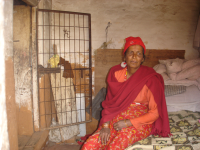KATHMANDU, Apr 9 (IPS) - Bishnu Maya Dahal, 51, dreams of going back to her village in eastern Nepal.
The family fled to Kathmandu in 2001 after her husband, a member of the then ruling Nepali Congress was brutally beaten by Maoist rebels for daring to defy a ban and run in village-level elections in 2001.
Chailal was assaulted, his legs crushed under a giant stone rice crusher, and left for dead. He survived, but his 22-year-old son, who had climbed a tree to save himself from the Maoists, broke his back when a branch snapped under his weight.
Dahal says her son breathed his last as he was carried to the nearest hospital in the district headquarters, an arduous two-day mountain journey on a porter's back.
The three-member family lives in the premises of an early 19th century temple in Thapathali, the heart of Kathmandu. Dahal's 13-year-old son performs the puja (ritual prayers) in the Gopal mandir. The government pays temple priests a yearly honorarium of 300 Nepali rupees (roughly 3.5 USD). Apart from this, the priest is entitled to keep the fruits and rice offered by devotees.
|
"I keep wishing if only we could return to our home," she says longingly.
In June 2008, Dahal did try to return to her home in Okhaldhunda district. She was given 5,000 rupees (about 60 dollars) from the Kathmandu district administration office for the journey back. But without any means of support or assurances from the government, she could not stay on. "I want help to rebuild my house … My cattle, my land have been taken by my neighbours," she says.
An armed uprising led by Maoist rebels that began in rural Nepal in 1996 and spread like wildfire uprooted thousands of families. In April 2006, a people's revolution toppled the traditional monarchy. The Maoists declared a ceasefire, and joined the interim government.
In elections in April 2008, the former rebels won the largest number of seats to the new Constituent Assembly but failed to achieve an outright majority. A month later, Nepal was declared a republic. Now, the coalition government led by the erstwhile Maoists has been tasked to draft a new constitution by August 2010.
Issues like the rehabilitation of internally displaced people (IDP) have been put on the back burner.
A National IDP Policy was announced in 2007 by the interim government. It was drafted by the Ministry of Peace and Reconciliation (MoPR) with support from the Norwegian Refugee Council, a non-governmental organisation, and other agencies such as Nepal's National Human Rights Commission, and the UN Office of the Commission of Human Rights in Nepal.
According to a MoPR task force to collect data of the conflict affected individual, family and infrastructure, the number of IDPs has gone from 9,000 families (a total of 25,000 individuals) in 2005 to 14,063 families (52,332 people) in 2008. The numbers swelled dramatically after the endorsement of the National IDP Policy.
Khem Bahadur Giri, a member of the task force, told IPS that data on a total 67,000 people has been collected till date but the new IDPs are yet to be registered in the official document. Roughly 50 percent of the displaced and documented are women, he said.
Like Dahal, Kusum Rawat is on the government's list of IDPs. She is from a village in remote Humla district.
Since her arrival in Kathmandu five years ago she has been the family's sole breadwinner. Her husband has retreated into himself since Maoists beat him in front of his family. Their five children - two girls and three boys between the ages of 4 and 14 – eat whenever Rawat can find work as a daily wager.
"I do everything - from carrying stones to washing dishes - but it (work) is not regular," she confides. "When there is no food, we go to bed on empty stomachs."
Unlike Dahal, Rawat who cannot be more than 40 years old, does not want to go back to her village. "I wake up praying I will get some work so I can feed my family. If the government can ensure (employment) what more can I ask?" she says simply.
The government introduced a return and reintegration package in October 2007 under the National IDP Policy, but has focussed only on sending IDPs home.
Durganidhi Sharma, joint secretary in MoPR, says the government does not have the money to integrate and resettle uprooted families.
Registered IDPs are offered travel fares, a daily travel allowance and a resettlement allowance of roughly 7,200 rupees for a four-month period, which works out to less than one dollar a day. According to Sharma, 27,000 of the 52,332 registered IDPs have taken the money to return home.
However, the moot point is: how many returnees will stay on in the absence of a government policy on rehabilitation and funds to implement it. Both Dahal and Rawat took the transportation money but opted to return to Kathmandu.
Sharma does not deny that most IDPs are likely to choose urban homelessness over rural insecurity. "If IDP regulation had been in place then it would have been more effective to keep track of the IDPs and their status and to support them," he says.
But he holds out hope for Dahal. "The MoPR has forwarded the IDP regulation draft to the prime minister's office and we are hoping it will be endorsed soon."




No comments:
Post a Comment